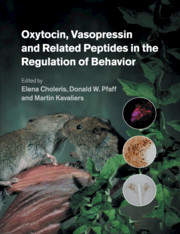Crossref Citations
This Book has been
cited by the following publications. This list is generated based on data provided by Crossref.
Kelly, Aubrey M.
and
Goodson, James L.
2014.
Hypothalamic oxytocin and vasopressin neurons exert sex-specific effects on pair bonding, gregariousness, and aggression in finches.
Proceedings of the National Academy of Sciences,
Vol. 111,
Issue. 16,
p.
6069.
Axelevitch, Alexander
and
Akselevich, Vasilisa
2015.
Evaluation of the neuropeptides level using a surface enhanced mobile spectroscopy system.
p.
334.
Nave, Gideon
Camerer, Colin
and
McCullough, Michael
2015.
Does Oxytocin Increase Trust in Humans? A Critical Review of Research.
Perspectives on Psychological Science,
Vol. 10,
Issue. 6,
p.
772.
Dando, Malcolm
2015.
Neuroscience and the Future of Chemical-Biological Weapons.
p.
123.
Brunnlieb, Claudia
Nave, Gideon
Camerer, Colin F.
Schosser, Stephan
Vogt, Bodo
Münte, Thomas F.
and
Heldmann, Marcus
2016.
Vasopressin increases human risky cooperative behavior.
Proceedings of the National Academy of Sciences,
Vol. 113,
Issue. 8,
p.
2051.
Ebensperger, Luis A.
and
Hayes, Loren D.
2016.
Sociobiology of Caviomorph Rodents.
p.
326.
2016.
Sociobiology of Caviomorph Rodents.
Muroy, Sandra E
Long, Kimberly L P
Kaufer, Daniela
and
Kirby, Elizabeth D
2016.
Moderate Stress-Induced Social Bonding and Oxytocin Signaling are Disrupted by Predator Odor in Male Rats.
Neuropsychopharmacology,
Vol. 41,
Issue. 8,
p.
2160.
Theofanopoulou, Constantina
Boeckx, Cedric
and
Jarvis, Erich D.
2017.
A hypothesis on a role of oxytocin in the social mechanisms of speech and vocal learning.
Proceedings of the Royal Society B: Biological Sciences,
Vol. 284,
Issue. 1861,
p.
20170988.
Baran, Nicole M.
2017.
Sensitive Periods, Vasotocin-Family Peptides, and the Evolution and Development of Social Behavior.
Frontiers in Endocrinology,
Vol. 8,
Issue. ,
Orger, Michael B.
and
de Polavieja, Gonzalo G.
2017.
Zebrafish Behavior: Opportunities and Challenges.
Annual Review of Neuroscience,
Vol. 40,
Issue. 1,
p.
125.
Kawada, Atsushi
Nagasawa, Miho
Murata, Aiko
Mogi, Kazutaka
Watanabe, Katsumi
Kikusui, Takefumi
and
Kameda, Tatsuya
2019.
Vasopressin enhances human preemptive strike in both males and females.
Scientific Reports,
Vol. 9,
Issue. 1,
Cid-Jofré, Valeska
Moreno, Macarena
Reyes-Parada, Miguel
and
Renard, Georgina M.
2021.
Role of Oxytocin and Vasopressin in Neuropsychiatric Disorders: Therapeutic Potential of Agonists and Antagonists.
International Journal of Molecular Sciences,
Vol. 22,
Issue. 21,
p.
12077.
King, Stephanie L.
Connor, Richard C.
Krützen, Michael
and
Allen, Simon J.
2021.
Cooperation-based concept formation in male bottlenose dolphins.
Nature Communications,
Vol. 12,
Issue. 1,
Prior, Nora H.
Bentz, Ehren J.
and
Ophir, Alexander G.
2022.
Reciprocal processes of sensory perception and social bonding: an integrated social‐sensory framework of social behavior.
Genes, Brain and Behavior,
Vol. 21,
Issue. 3,
Zablocki‐Thomas, Pauline
Lau, Allison
Witczak, Lynea
Dufek, Madison
Wright, Amber
Savidge, Logan
Paulus, John
Baxter, Alexander
Karaskiewicz, Chloe
Seelke, Adele M. H.
Freeman, Sara M.
Ferrer, Emilio
and
Bales, Karen L.
2023.
Intranasal oxytocin does not change partner preference in female titi monkeys (Plecturocebus cupreus), but intranasal vasopressin decreases it.
Journal of Neuroendocrinology,
Vol. 35,
Issue. 10,



